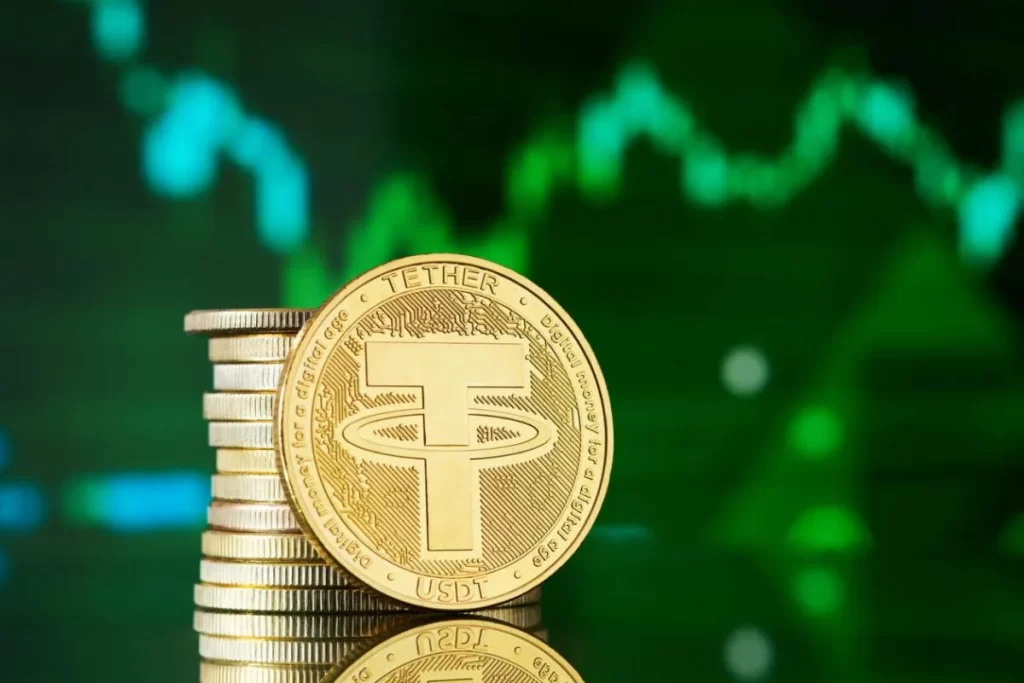Tether (USDT) is a cryptocurrency that belongs to the category of stablecoins, i.e. digital assets pegged to the value of traditional currencies or other stable assets. USDT was launched in 2014 by Tether Limited and has since become the most popular stablecoin in the world in terms of trading volume and market capitalization.
The main idea behind Tether is to maintain a stable value of 1 USD (1 USDT = 1 USD), making it an attractive tool for traders and users who want to avoid the volatility inherent in other cryptocurrencies such as Bitcoin or Ethereum.
USDT does not have its own blockchain, but functions as a second-tier token on several networks, including Ethereum (ERC-20), Tron (TRC-20), Binance Smart Chain, Solana, Polygon, and others.
As of 2025, Tether ranks third among all cryptocurrencies in terms of market capitalization, behind only Bitcoin (BTC) and Ethereum (ETH), and holds a share of more than 70% among stablecoins.
History of creation
Tether appeared in July 2014 under the name Realcoin, founded by Brock Pierce, Reeve Collins, and Craig Sellars, well-known figures in the crypto industry. Pierce was a co-founder of Blockchain Capital and Block.one (EOS), Collins headed Tether for the first two years, and Sellars participated in the Omni and Bitfinex projects.
In November 2014, the project was rebranded to Tether, and in January 2015, it began trading on the Bitfinex exchange, which has close ties to Tether Limited through its common parent company iFinex.
USDT initially operated on the Bitcoin blockchain through the Omni Layer protocol, but later expanded to other networks to increase transaction speed and reduce costs. The goal of creating Tether was to combine the advantages of cryptocurrencies (speed, transparency, decentralization) with the stability of the US dollar.
How Tether works
Tether is a fiat-backed stablecoin, which means that each USDT token is theoretically backed by an equivalent amount in US dollars or their equivalents in Tether Limited's reserves.
The company claims that it issues new tokens only after receiving the corresponding fiat currency deposits, and when USDT is redeemed, these tokens are "burned" to maintain a 1:1 peg to the dollar.
Tether's reserves include:
- Cash and cash equivalents (e.g., short-term deposits).
- US government bonds (the largest share is 76-82% as of 2024).
- Precious metals (about 3-4%).
- Bitcoin (about 2-3%).
- Secured loans and other investments.
Daily reports on reserves are published on Tether's official website, although no full-fledged audit has been conducted so far - only attestations from third-party firms such as BDO.
As of August 2024, Tether reported assets of $118.4 billion, which exceeds the circulating supply of USDT ($114 billion), with excess reserves of $5.3 billion.
Features and benefits
- Stability: Being pegged to the US dollar makes USDT resistant to sharp fluctuations typical of the cryptocurrency market.
- Liquidity: USDT is the most common stablecoin available on most exchanges and is often used as the base currency for trading pairs.
- Speed and low costs: Thanks to the support of fast blockchains such as Tron or Solana, USDT transactions are fast and cheap.
- Versatility: Tether is used for trading, transfers, value storage, and even real-world payments (e.g. through partnerships with Travala).
- Globalization: USDT allows you to make international transactions without intermediaries, bypassing traditional banking systems.
Development history and key events
2014-2015
Launch and first trading on Bitfinex.
2017
The growth in popularity parallels the bull run of the crypto market. In November, hackers stole $31 million USDT, which led to a hard fork to block the stolen tokens.
2019
Tether surpassed Bitcoin in terms of trading volume, becoming the most popular cryptocurrency in terms of daily turnover. The same year, the statement of reserves was changed: instead of 100% of cash, it reads "traditional currency, equivalents, and other assets."
2021
Plea deal with the New York prosecutor's office over allegations of concealing a $850 million reserve shortfall. Tether and Bitfinex paid a fine of $18.5 million.
2022
Expanding to new blockchains and partnering with the Swiss city of Lugano to pay taxes in USDT.
2023-2024
Tether has frozen $225 million USDT related to fraud in Southeast Asia in cooperation with OKX and law enforcement. The company reported a profit of $5.2 billion for the first half of 2024.
Controversy and criticism
Tether has repeatedly faced criticism:
- Transparency of reserves: Until 2019, Tether claimed that every USDT was backed 1:1 by cash, but later admitted that only 74% of reserves were cash and equivalents. This raised doubts about reliability.
- Market manipulation: Research in 2018 (Griffin & Shams) suggested that the issuance of USDT affected the price of Bitcoin during downturns, although Tether denies these allegations.
- Regulatory pressure: In 2017, the US CFTC issued subpoenas to Tether and Bitfinex, and in 2022, a court in New York ordered the provision of reserve documents.
Nevertheless, USDT maintains its leadership, and the company is working to increase transparency, reducing risks by diversifying reserves.
As of March 2025, the market capitalization of USDT exceeds $143 billion (according to the latest Coinbase data), with a circulating supply of 143,465,026,356 tokens.
The daily trading volume fluctuates between $55-60 billion, which is often higher than the volume of Bitcoin. The USDT price is stable at $1, although minor deviations (for example, up to $0.88 in 2018) have occurred in history due to market panic.
In 2024, Tether announced a restructuring into four divisions: stablecoins, bitcoin mining, education, and artificial intelligence, demonstrating its ambition to go beyond being a USDT issuer.
Tether (USDT) is not just a cryptocurrency, but a key element of the digital finance ecosystem that provides stability and liquidity.
Its popularity is attributed to its ease of use and widespread acceptance, although controversy over reserves and transparency leaves room for skepticism. For traders, USDT is a "digital dollar," for investors, it is a hedge against volatility, and for critics, it is a mystery that needs more transparency. In 2025, Tether will continue to dominate the stablecoins, and its future will depend on its ability to adapt to regulatory requirements and maintain user trust.


